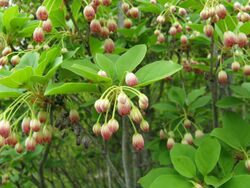Biology:Enkianthus campanulatus
| Enkianthus campanulatus | |
|---|---|

| |
| Scientific classification | |
| Kingdom: | Plantae |
| Clade: | Tracheophytes |
| Clade: | Angiosperms |
| Clade: | Eudicots |
| Clade: | Asterids |
| Order: | Ericales |
| Family: | Ericaceae |
| Genus: | Enkianthus |
| Species: | E. campanulatus
|
| Binomial name | |
| Enkianthus campanulatus (Miq.) G.Nicholson
| |
The hardiest of Enkianthus species is E. campanulatus (furin-tsutsuji or redvein enkianthus), a medium-sized, narrow, upright, deciduous shrub. Its bright green glossy foliage gives brilliant coppery to red fall colors. In spring it offers a profusion of bell-shaped (campanula, "little bell"), creamy white flowers with red veins, similar to those of the distantly related Pieris.[1]
The plant was brought to England by Charles Maries, who was plant-hunting in Japan at the time for Veitch Nurseries. The shrub can exceed expectations of height under the right circumstances, as at William Robinson's Gravetye Manor, where a pair planted about the turn of the 20th century reached 15 ft (5 m).[2]
Characteristics
Exposure: Full sun to part shade
Spacing: 4' to 5' apart
Average height x width: 10' tall x 5' wide
Fertilizing: Fertilize in spring just before new growth begins
Cold hardiness: -20 °F
Water use: Keep soil evenly moist. Prefers acid, well-drained soil.
Widely cultivated as an ornamental plant in parks and gardens, this plant has gained the Royal Horticultural Society's Award of Garden Merit.[3][4]
References
- ↑ "Enkianthus campanulatus". Missouri Botanical Garden. http://www.missouribotanicalgarden.org/gardens-gardening/your-garden/plant-finder/plant-details/kc/k210/enkianthus-campanulatus.aspx. Retrieved 25 July 2013.
- ↑ Alice M. Coats, Garden Shrubs and Their Histories (1964) 1992, s.v. "Enkianthus".
- ↑ "Enkianthus campanulatus". Royal Horticultural Society. https://www.rhs.org.uk/Plants/6387/Enkianthus-campanulatus/Details. Retrieved 6 June 2020.
- ↑ "AGM Plants - Ornamental". Royal Horticultural Society. July 2017. p. 35. https://www.rhs.org.uk/plants/pdfs/agm-lists/agm-ornamentals.pdf. Retrieved 6 February 2018.
Wikidata ☰ Q1039336 entry
 |

